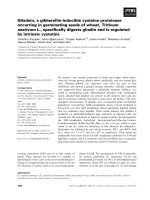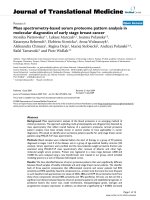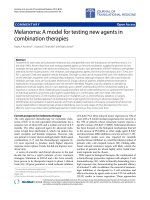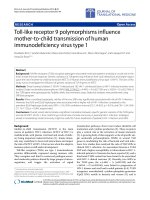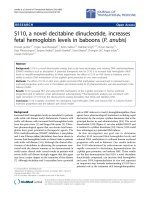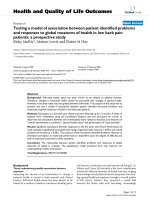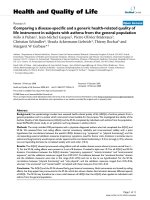báo cáo hóa học: " Influenza A (H1N1) 2009: Impact on Frankfurt in due consideration of health care and public health" pptx
Bạn đang xem bản rút gọn của tài liệu. Xem và tải ngay bản đầy đủ của tài liệu tại đây (488.13 KB, 7 trang )
Wicker et al. Journal of Occupational Medicine and Toxicology 2010, 5:10
/>Open Access
RESEARCH
BioMed Central
© 2010 Wicker et al; licensee BioMed Central Ltd. This is an Open Access article distributed under the terms of the Creative Commons
Attribution License ( which permits unrestricted use, distribution, and reproduction in
any medium, provided the original work is properly cited.
Research
Influenza A (H1N1) 2009: Impact on Frankfurt in
due consideration of health care and public health
Sabine Wicker*
1
, Holger F Rabenau
2
, Harald Bias
3
, David A Groneberg
3
and René Gottschalk
4
Abstract
Background: In April 2009 a novel influenza A H1N1/2009 virus was identified in Mexico and in the United States
which quickly spread around the world. Most of the countries established infection surveillance systems in order to
track the number of (laboratory-confirmed) H1N1 cases, hospitalizations and deaths.
Methods: The impact of the emergence of the novel pandemic (H1N1) 2009 virus on Frankfurt was statistically
evaluated by the Health Protection Authority, City of Frankfurt am Main.
Vaccination rates of the health care workers (HCWs) of the University Hospital Frankfurt were measured by the
Occupational Health Service.
Results: Although the virulence of pandemic (H1N1) 2009 seems to be comparable with seasonal influenza, a major
patient load and wave of hospital admissions occurred in the summer of 2009.
Even though the 2009 vaccination rate of the University Hospital Frankfurt (seasonal influenza [40.5%], swine flu
[36.3%]) is better than the average annual uptake of influenza vaccine in the German health care system
(approximately 22% for seasonal and 15% for swine flu), vaccination levels remain insufficient.
However, physicians were significantly (p < 0.001) more likely to have been vaccinated against swine flu and seasonal
influenza than nurses.
Conclusions: The outbreak of the pandemic (H1N1) 2009 in April 2009 provided a major challenge to health services
around the world. Nosocomial transmission of H1N1/2009 has been documented. Present experience should be used
to improve pandemic preparedness plans and vaccination programs ought to target as many HCWs as possible.
Background
When the pandemic (H1N1) 2009 flu outbreak began in
April 2009, the Centers for Disease Control (CDC) in
U.S.A. and the Robert Koch Institute (RKI) in Germany
began tracking and reporting the number of laboratory-
confirmed influenza A H1N1/2009 cases, hospitaliza-
tions and deaths. These initial case counts (which were
discontinued on July 24, 2009 in U.S.A. and on November
14, 2009 in Germany) are thought to represent a signifi-
cant undercount of the actual number of influenza A
H1N1/2009 flu cases, especially in the U.S. [1].
Almost a year later (April, 2010), influenza activity con-
tinues to decline or remain low in most countries. Based
on FluNet data />home.asp collected by 32 countries from February 6 - 13,
2010, 48.3% of specimens testing positive for influenza
were typed as influenza A and 51.7% as influenza B. In
nearly all countries where influenza infection has been
reported, the influenza A H1N1/2009 continues to pre-
dominate among all subtyped influenza A viruses. Out of
all subtyped influenza A viruses, 90% were influenza A
H1N1/2009 positive [2].
Through April 13, 2010, a total of 226,125 infections
with pandemic (H1N1) 2009 had been reported in Ger-
many, including 253 deaths [3].
* Correspondence:
1
Occupational Health Service, Hospital of the Johann Wolfgang Goethe-
University, Theodor-Stern-Kai 7, 60590 Frankfurt am Main, Germany
Full list of author information is available at the end of the article
Wicker et al. Journal of Occupational Medicine and Toxicology 2010, 5:10
/>Page 2 of 7
The purpose of the present study was to ascertain the
impact of the emergence of the novel influenza A H1N1/
2009 virus on Frankfurt, a metropolis with the largest air-
port in Germany. Furthermore, we assessed vaccination
rates of health care workers (HCWs) of the University
Hospital Frankfurt.
Methods
Frankfurt am Main has 675,729 inhabitants making it the
fifth largest city of Germany. Frankfurt Airport plays a
key role in international air transportation. With more
than 50.9 million passengers in 2009, it ranks eighth in
the league table of the world's largest airports. In Europe,
it is number three in terms of passengers after London-
Heathrow and Paris-Charles de Gaulle. Nowadays infec-
tious diseases and pandemics are primarily spread
through aviation, for this reason there is a high risk of
introducing emerging infectious diseases in the Rhein-
Main region [4].
In Frankfurt am Main there are approximately 604,500
workplaces, therefore Frankfurt holds the highest job
density per inhabitant in Germany. Approximately 89.2%
are employed in the service sector and about 10.7% in
production industries [5].
The duties and responsibilities of the public health ser-
vice in Frankfurt are assumed by the Health Protection
Authority of the City of Frankfurt am Main. The local
health authority advises the population on the prevention
of infectious diseases and on the prophylaxis of transmis-
sion of infections. People with suspected or confirmed
influenza A H1N1/2009 have been reported to the
Municipal Health Protection Authorities since April 30,
2009. The Office monitors the number of patients who
have been detected as confirmed, probable or suspicious
cases, patients who require hospitalization and the fatal
causalities as well.
The Health Protection Authority of the City of Frank-
furt am Main co-ordinated, on behalf of the Ministry of
Health of Hesse, the swine-flu vaccination campaign in
Frankfurt. Vaccinations have been administered in the
office since the end of October 2009 in the following
order: prioritized risk groups (HCWs, fire-fighters etc.),
patients with chronic diseases, pregnant women, house-
hold contact of non-vaccinated risk groups, healthy chil-
dren and young adults up to 24, healthy adults from the
age range 25-59 and lastly people over the age of 60.
There are 16 hospitals in Frankfurt; the biggest one is
the Frankfurt University Hospital, which is a 1,169-bed
hospital with 3,900 employees (including 726 physicians,
1,300 nurses and nursing assistants) working in 24 medi-
cal departments and research facilities.
From October 2009 to March, 2010, the Occupational
Health Service of the University Hospital offered seasonal
influenza and swine flu vaccinations free of charge to
HCWs.
The Occupational Health Service, the Institute of Med-
ical Microbiology and Infection Control and the Institute
of Medical Virology provided recommendations for
infection control of influenza A H1N1/2009 in the Uni-
versity Hospital in co-operation with the Health Protec-
tion Authority.
Statistical analysis
For statistical analysis, data was inserted into a Microsoft
Excel database file. This file represented the basis for the
detailed analysis using standard MS Excel capabilities. P
values (χ
2
test - two-tailed χ
2
-test, Yates rectified) were
calculated using the BiAS program for Windows 8.3
(Epsilon Verlag, Hochheim Darmstadt 2007). P values <
0.05 were defined as statistically significant.
Results
By March 5, 2010, in total 2,214 cases of influenza A/
H1N1/2009 had been confirmed and had been reported
to the Health Protection Authority of the City of Frank-
furt am Main (see Figure 1). These cases resulted in 4
known deaths.
Overall 10,761 H1N1 vaccinations were administered
in Frankfurt am Main (see Figure 2). This led to a rather
low vaccination rate (< 1.6%) of the inhabitants of Frank-
furt (n = 675,729). Unfortunately, the vaccination rate of
the inhabitants of Frankfurt cannot be calculated exactly,
owing to the fact that a proportion of immunizations had
been given to persons whose main residence is not Frank-
furt am Main. These vaccinees were vaccinated e.g. at
their workplaces.
From October 2009 to the end of February 2010, over-
all, 40.5% (n = 1,579/3,900) of the HCWs of the University
Hospital Frankfurt were vaccinated against seasonal
influenza, and 36.3% (n = 1,416/3,900) were vaccinated
against influenza A/H1N1/2009 ("swine flu").
The average age of an employee of the University Hos-
pital is 42 years, the average age of the seasonal influenza
vaccinees was 39.6 (range: 19-67 years), the average age of
the swine flu vaccinees was 38.2 (range: 20-64 years).
Physicians (n = 586/726) were significantly more likely
to have been vaccinated against swine flu than nurses (n
= 393/1300) (80.7% versus 30.2%, respectively; p < 0.001).
Roughly the same was shown for seasonal influenza.
Men and women were analyzed separately, providing
an insight into gender-specific determinants of immuni-
zation behavior. Table 1 and 2 present vaccination rates
according job description and gender, separated for each
vaccine and HCW who received both vaccines. In total,
48% of the H1N1 ("swine flu") vaccinees were also given
Wicker et al. Journal of Occupational Medicine and Toxicology 2010, 5:10
/>Page 3 of 7
the seasonal flu vaccine and 43% of the seasonal influenza
vaccinees received the H1N1 vaccine as well (see Table 2).
Overall, 49.2% (312/634) of the male H1N1 vaccinees
also received a seasonal flu vaccination and 54.4% (312/
574) of the seasonal flu vaccines received a H1N1/2009
vaccination (p = 0.074).
While there is no significant difference in the propor-
tion of male and female H1N1/2009 vaccinated HCWs
who also received a seasonal flu vaccination (p = 0.393), a
gender-specific difference could have been demonstrated
for seasonal flu vaccinees who also received a H1N1/2009
vaccination (male 54.4% [312/574] versus female 36.5%
[367/1,005]; p < 0.001).
Discussion
Evidence from the past few months demonstrates that the
influenza A H1N1/2009 virus has rapidly established
itself and is now the dominant influenza strain in most
parts of the world [2,6].
Influenza viruses are highly contagious; the basis repro-
duction number (R
0
) of influenza A H1N1/2009 was esti-
mated to be between 1.4 and 1.6 [7]. If the R
0
is greater
than 1, a pandemic might occur [6].
In the City of Frankfurt am Main 2,214 probable and
confirmed cases were notified to the Health Protection
Authority. However, this number reflects only a small
fraction of the people with the pandemic (H1N1) 2009
influenza infection. Estimated numbers of unknown
cases will be distinctly higher for a variety of reasons,
especially since not all patients seek medical care due to a
mild course of the disease. In a study performed between
April and July 2009 in the U.S., the estimated numbers of
unknown cases were calculated to 79:1 with a 90% proba-
bility range of 47-148, which means that one registered
flu case correspond with 79 unknown cases [8]. Estimat-
ing the numbers of unknown cases to be 70 for the City of
Frankfurt am Main a total of nearly 155,000 cases (or 23%
of the inhabitants) seems to be realistic assessment.
Fortunately, the majority of cases are considered to be
lenient. Fatal causes occur mostly but not exclusively in
patients with underlying medical conditions (chronic dis-
eases such as asthma, diabetes, immunosuppression, obe-
sity).
The working environment may be crucial to pandemic
preparedness planning [9]. Workplaces are potential
sources of disease transmission, and illness and absentee-
ism might lead to substantial productivity losses and
could disrupt the functionality of the health care system
[10]. HCWs are at risk of occupational exposure to influ-
enza and may transmit the infection to their patients and
co-workers [11,12]. The influenza attack rate among
unprotected HCWs might be approximately 60% higher
than that of the general population, which would result in
substantial absenteeism and morbidity [13]. On account
Figure 1 Reported cases of influenza A H1N1/2009 (n = 2,214) in Frankfurt am Main. Starting from November 16, 2009 only laboratory con-
firmed cases were counted.
H1N1 cases in Frankfurt/Main from September, 2009 to March, 2010
14
10
11
13
51
207
827
585
253
121
65
25
10
3
5
9
2
1
0
2
00
0
100
200
300
400
500
600
700
800
900
Sep 28
Oct 4
Oct 5
Oct 11
Oct 12
Oct 18
Oct 19
Oct 25
Oct 26
Nov 1
Nov 2
Nov 8
Nov 9
Nov 15
Nov 16
Nov 22
Nov 23
Nov 29
Nov 30
Dez 6
Dez 7
Dez 13
Dez 14
Dez 20
Dez 21
Dez 27
Dez 28
Jan 3
Jan 4
Jan 10
Jan 11
Jan 17
Jan 18
Jan 24
Jan 25
Jan 31
Feb 1
Feb 7
Feb 8
Feb 14
Feb 15
Feb 21
Feb 22
Feb 28
Number of flu cases per week
Wicker et al. Journal of Occupational Medicine and Toxicology 2010, 5:10
/>Page 4 of 7
of this, the health care system needs to be aware of the
safety of their HCWs because they are at significant risk
of becoming infected [14].
Recent data suggest that the influenza A H1N1/2009
virus is transmitted via large particle droplets [15].
Because large droplets remain suspended in the air only
for a short time, close contact is a precondition for virus
transmission [6]. Occupationally acquired infections of
influenza A H1N1/2009 in HCWs have been documented
[16]. Unfortunately, nurses (who usually have both closer
and longer contact with patients than any other profes-
sional group of HCWs) demonstrate flu vaccination rates
which are 2 up to 2.5 times lower than the vaccination
rates of physicians (see Table 1).
Vaccination seems to be the best defense against high
infection rates among susceptible and vulnerable people.
Nevertheless, compliance rates with influenza vaccina-
tion among HCWs and the general population remain
low [17-19].
Current data shows that by the end of December 2009
as few as 22% of U.S. HCWs had received the swine flu
vaccine [6]. Vaccination rates in Germany are just as low,
an estimated 15% of German HCWs have received the
swine flu vaccine [17]. Albeit, the vaccination rate of the
University Hospital Frankfurt is better, both for swine flu
(36.3%), and seasonal influenza (40.5%), than the average
annual uptake of the influenza vaccine in the German
health care system (approximately 22%). Nevertheless,
vaccination levels among HCWs remain insufficient. It is
crucial that an effective response to a pandemic as well as
a mitigation of the associated morbidity and mortality
ought to be predicated on a vaccinated, working, and
informed health care population [6].
Compared to other HCWs, nurses have lower flu vacci-
nation rates and seem to be most doubtful of influenza
vaccine efficacy and necessity and most afraid of their
adverse effects. A study of a large tertiary medical center
revealed that nurses had fears and misconception about
influenza vaccination despite perceived receipt of ade-
quate information to support good decision-making. Fur-
thermore, nurses judged influenza vaccination as a
personal health choice, not as an evidence-based nursing
intervention [20].
The pulmonary pathologic findings in fatal causalities
caused by influenza A H1N1/2009 virus are similar to
findings identified in the 1918 and 1957 pandemics [21].
There is still considerable uncertainty about how the
influenza A H1N1/2009 virus will behave over the com-
ing months and years. To achieve data for prediction of
the future development an early and consequent surveil-
lance and monitoring system with a standardized and
coordinated international information sharing is crucial
for the management not only for pandemic influenza but
all pandemics [22]. The setting of standards for coping
Figure 2 Number of H1N1/2009 immunizations in Frankfurt am Main (n = 10,761). Overall, 4,379 vaccinations were administered by the Health
Protection Authority of Frankfurt am Main. In total 6,382 vaccinations were administered by other immunization stations (e.g. University Hospital
Frankfurt).
H1N1 immunizations in Frankfurt/Main
46
27
38
11
10
15
17
9
5
3
2123
846
209
175
509
45
14
31
14
5
17
21
11
115
228
584
1403
1490
378
439
1536
387
0
500
1000
1500
2000
2500
Oct 26
Nov 1
Nov 2
Nov 8
Nov 9
Nov 15
Nov 16
Nov 22
Nov 23
Nov 29
Nov 30
Dez 6
Dez 7
Dez 13
Dez 14
Dez 20
Dez 21
Dez 27
Dez 28
Jan 3
Jan 4 Jan
10
Jan 11
Jan 17
Jan 18
Jan 24
Jan 25
Jan 31
Feb 1
Feb 7
Feb 8
Feb 14
Number of immunizations per week
City Health Office Immunization elsewhere
Wicker et al. Journal of Occupational Medicine and Toxicology 2010, 5:10
/>Page 5 of 7
with this should be subject to a municipal or local deci-
sion but also established at national and global levels.
National authorities need to know how the pandemic is
evolving, not only in their own country, but also in neigh-
boring countries and continents [23].
Thus far, in contrast to seasonal influenza viruses, the
influenza A H1N1/2009 virus has disproportionately
affected young people, and this is where most complica-
tions have occurred, particularly in those with pre-exist-
ing chronic conditions. At this point of time the virulence
of influenza A H1N1/2009 virus is similar to that of sea-
Table 2: Characteristics of HCWs who received both influenza vaccines (against H1N1/2009 and seasonal flu)
Proportion of H1N1 ("swine flu") vaccinees who also received
seasonal influenza vaccination [%]
Vaccination H1N1 [n] [%] p-value [%]
Total (n = 1,416) 679 48.0
Male (n = 634) 312 49.2 0.393
Female (n = 782) 367 46.9 0.393
Job description
Physicians (n = 586) 331 56.5 0.008
Nurses (n = 393) 188 47.8 0.008
Medical technicians (n = 101) 45 44.6
Scientists (n = 176) 52 29.5
Administrative personnel (n = 93) 39 41.9
Others (e.g.: Maintenance, catering, workshop, transport) (n = 67) 24 35.8
Table 1: Demographic characteristics of vaccines (separated for each kind of flu vaccine)
H1N1 ("swine flu") Seasonal influenza
n [%] p-value n [%] p-value
Vaccination rate 1,416/
3,900
36.3 1,579/
3,900
40.5 T P <
0.001
Male (n = 1,158) 634 54.7 p <
0.001
574 49.6 p <
0.001
P =
0.013
Female (n = 2,742) 782 28.5 p <
0.001
1,005 36.7 p <
0.001
P <
0.001
Job description
Physicians (n = 726) 586 80.7 p <
0.001
497 68.5 p <
0.001
P <
0.001
Nurses (n = 1,300) 393 30.2 p <
0.001
432 33.2 p <
0.001
P =
0.100
Medical technicians(n = 850) 101 11.8 171 20.1
Scientists (n = 224) 176 78.6 127 56.7
Administrative personnel (n = 300) 93 31.0 154 51.3
Others (e.g.: Maintenance,
catering, workshop, transport)
(n = 500)
67 13.4 198 39.6
Wicker et al. Journal of Occupational Medicine and Toxicology 2010, 5:10
/>Page 6 of 7
sonal influenza viruses [6]. However, we do not yet know
if there might be a change.
Limitations
To appreciate the results of our study, some potential lim-
itations need to be addressed:
First, the results from a single academic institution or
city may not be applicable to other institutions and other
geographic regions. Second, the number of HCWs who
received either their seasonal flu vaccination or the swine
flu vaccination from their general practitioner or other
health authorities could not be calculated. Third, the
immunization rate and the overall number of cases of the
inhabitants of Frankfurt could only be estimated.
Conclusions
This influenza A/H1N1 pandemic differs in significant
aspects from the experiences gained from earlier pan-
demics. All simulations which predicted the potential
course of this pandemic have been wrong. Measures of
infection control of the public health authorities are in
place and have been proven to be effective irrespective of
the specific agents. A practice-based and future-oriented
perfect preparation for taking on the challenges of pan-
demics is considered to be indispensable. Due to infor-
mational needs of the public and employees, professional,
constant and reliable risk communication is crucial to
successfully cope with pandemics.
Conflict of interests
The views in this article are the personal views of the
authors and do not necessarily represent the views of the
professional organizations or institutions within which
we are members.
The authors declare that they have no competing inter-
ests.
Authors' contributions
SW and RG drafted the manuscript.
SW, HFR and RG conceived the study and the study design, performed the
analysis and interpretation of the data.
DAG and HB: scientific supervision, revised the manuscript critically for impor-
tant intellectual content.
All authors read and approved the final manuscript.
Acknowledgements
The authors would like to thank Dr. Domenica Varwig (Department of Derma-
tology), Dr. Regina Allwinn and Dr. Miriam Wittek (Institute of Medical Virology)
for their support during the swine flu vaccination campaign.
Author Details
1
Occupational Health Service, Hospital of the Johann Wolfgang Goethe-
University, Theodor-Stern-Kai 7, 60590 Frankfurt am Main, Germany,
2
Institute
of Medical Virology, Hospital of the Johann Wolfgang Goethe-University, Paul-
Ehrlich-Str. 40, 60596 Frankfurt am Main, Germany,
3
Institute of Occupational
Medicine, Charité - Universitätsmedizin Berlin, Free University and Humboldt-
University Berlin, Thielalllee 69-73, 14195 Berlin, Germany and
4
Health
Protection Authority, City of Frankfurt am Main, Breite Gasse 28, 60313
Frankfurt am Main, Germany
References
1. Centers for Disease Control and Prevention (CDC): CDC Estimates of 2009
H1N1 Influenza Cases, Hospitalizations and Deaths in the United
States, April 2009 - January 16, 2010. [ />estimates_2009_h1n1.htm].
2. Centers for Disease Control and Prevention (CDC): 2009 H1N1 Flu:
International Situation Update February 26, 2010. [http://
www.cdc.gov/h1n1flu/updates/international/].
3. Robert Koch Institut: Arbeitsgemeinschaft Influenza. [http://
www.rki.de/cln_179/nn_205760/DE/Content/InfAZ/I/Influenza/IPV/
IPV__Node.html?__nnn = true].
4. Gaber W, Goetsch U, Diel R, Doerr HW, Gottschalk R: Screening for
Infectious Diseases at International Airports: The Frankfurt Model.
Aviat Space Environ Med 2009, 80:595-600.
5. Statistisches Jahrbuch: Statistical portrait Frankfurt am Main 2008
[ />Statistisches_Portrait_2009x.pdf]
6. Sullivan SJ, Jacobson RM, Dowdle WR, Poland GA: 2009 H1N1 Influenza.
Mayo Clin Proc 2010, 85:64-76.
7. Fraser C, Donnelly CA, Cauchemez S, Hanage WP, Van Kerkhove MD,
Hollingsworth TD, Griffin J, Baggaley RF, Jenkins HE, Lyons EJ, Jombart T,
Hinsley WR, Grassly NC, Balloux F, Ghani AC, Ferguson NM, Rambaut A,
Pybus OG, Lopez-Gatell H, Alpuche-Aranda CM, Chapela IB, Zavala EP,
Guevara DM, Checchi F, Garcia E, Hugonnet S, Roth C, WHO Rapid
Pandemic Assessment Collaboration: Pandemic potential of a strain of
influenza A (H1N1): early findings. Science 2009, 324:1557-1561.
8. Reed C, Angulo FJ, Swerdlow DL, Lipsitch M, Meltzer MI, Jernigan D, Finelli
L: Estimates of the Prevalence of Pandemic (H1N1) United States, April-
July 2009. Emerg Infect Dis 2009, 15:2004-2007.
9. Blake KD, Blendon RJ, Viswanath K: Employment and compliance with
pandemic influenza mitigation recommendations. Emerg Infect Dis
2010, 16:212-218.
10. Lee BY, Brown ST, Cooley PC, Zimmerman RK, Wheaton WD, Zimmer SM,
Grefenstette JJ, Assi TM, Furphy TJ, Wagener DK, Burke DS: A computer
simulation of employee vaccination to mitigate an influenza epidemic.
Am J Prev Med 2010, 38:247-257.
11. Blachere FM, Lindsley WG, Pearce TA, Anderson SE, Fisher M, Khakoo R,
Meade BJ, Lander O, Davis S, Thewlis RE, Celik I, Chen BT, Beezhold DH:
Measurement of airborne influenza virus in a hospital emergency
department. Clin Infect Dis 2009, 48:438-440.
12. Mermel LA: Preventing the spread of influenza A H1H1 2009 to health-
care workers. Lancet Infect Dis 2009, 9:723-724.
13. Cooley P, Lee BY, Brown S, Cajka J, Chasteen B, Ganapathi L, Stark JH,
Wheaton WD, Wagener DK, Burke DS: Protecting health care workers: a
pandemic simulation based on Allegheny County. Influenza other respi
viruses 2010, 4:61-72.
14. Shine KI, Rogers B, Goldfrank LR: Novel H1N1 influenza and respiratory
protection for health care workers. N Engl J Med 2009, 361:1823-1825.
15. Maines TR, Jayaraman A, Belser JA, Wadford DA, Pappas C, Zeng H, Gustin
KM, Pearce MB, Viswanathan K, Shriver ZH, Raman R, Cox NJ, Sasisekharan
R, Katz JM, Tumpey TM: Transmission and pathogenesis of swine-origin
2009 A(H1N1) influenza viruses in ferret and mice. Science 2009,
325:484-487.
16. Wicker S, Rabenau HF, Bickel M, Wolf T, Brodt R, Brandt C, Berger A, Doerr
HW, Lehmann R: Novel Influenza H1N1/2009: Virus transmission among
health care worker. Dtsch Med Wochenschr 2009, 134:2443-2446.
German
17. Rieser S: Swine flu: Criticism on vaccination-reluctance of physicians.
Dtsch Arztebl 2010, 107:1-2. German
18. Singleton JA, Santibanez TA, Lu PJ, Ding H, Euler GL, Armstrong GL, Bell BP,
Town M, Balluz L: Interim results: Influenza A (H1N1) 2009 Monovalent
vaccination coverage - United States, October - December 2009.
MMWR 2010, 59:1-5.
19. Poland GA, Tosh P, Jacobson RM: Requiring influenza vaccination for
health care workers: seven truths we must accept. Vaccine 2005,
23:2251-2255.
Received: 17 March 2010 Accepted: 26 April 2010
Published: 26 April 2010
This article is available from: 2010 Wicker et al; licensee BioMed Central Ltd. This is an Open Access article distributed under the terms of the Creative Commons Attribution License ( which permits unrestricted use, distribution, and reproduction in any medium, provided the original work is properly cited.Journal of Occupational Medicine an d Toxicology 2010, 5:10
Wicker et al. Journal of Occupational Medicine and Toxicology 2010, 5:10
/>Page 7 of 7
20. Rhudy LM, Tucker SJ, Ofstead CL, Poland GA: Personal choice or
evidence-based nursing intervention: nurses' decision-making about
influenza vaccination. Worldviews Evid Based Nurs 2010 in press.
21. Gill JR, Sheng ZM, Ely SF, Guinee DG, Beasley MB, Suh J, Deshpande C,
Mollura DJ, Morens DM, Bray M, Travis WD, Taubenberger JK: Pulmonary
pathologic findings of fatal 2009 pandemic influenza A/H1N1 viral
infections. Arch Pathol Lab Med 2010, 134:235-243.
22. World Health Organization (WHO): Human infection with pandemic
(H1N1) 2009 virus: updated interim WHO guidance on global
surveillance (2009). [ />guidance/surveillance/
WHO_case_definition_swine_flu_2009_04_29.pdf].
23. World Health Organization (WHO): Reducing transmission of pandemic
(H1N1) 2009 in school settings (2009). [ />resources/publications/reducing_transmission_h1n1_2009.pdf].
doi: 10.1186/1745-6673-5-10
Cite this article as: Wicker et al., Influenza A (H1N1) 2009: Impact on Frank-
furt in due consideration of health care and public health Journal of Occupa-
tional Medicine and Toxicology 2010, 5:10

